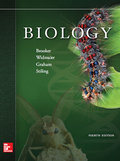
Concept explainers
Introduction: An allele is defined as a variant of a gene responsible for coding for a specific character. There are two different alleles for each phenotypic characteristics. One allele is dominant while the other form of the allele is recessive. The interaction between the alleles is responsible for showing phenotypic traits. Phenotypic traits are defined as the observable features, such as size, shape, color and many more.
Answer to Problem 1TY
Correct answer: Based on Mendel’s experiments, the expected
Explanation of Solution
Reason for correct answer:
According to Mendel’s experiment, when two heterozygous plants are crossed in the F2 generation, each offspring possessing even a single dominant characteristic will express the dominant gene. Of four plants, three plants should express the dominant trait. In the cross-section, only one out of every fourth plant will have both the recessive alleles and will be homozygous recessive. Such plant will express a recessive phenotype. So, the phenotypic ratio of the F2 generation will be 3:1.
Option c. is given as “3:1”.
According to Mendel’s experiments, in a single factor-cross, the expected phenotype ratio in the F2 generation is 3:1. Hence, the correct answer is option c.
Reason for incorrect answer:
Option a. is given as “1:2:1”.
The given ratio represents the genotypic ratio obtained in the F2 generation from a single-factor cross. Hence, option a. is incorrect.
Option b. is given as, “2:1”.
In the F2 generation, the phenotypic ratio obtained is three dominant phenotype expressing plants, including two heterozygous and one homozygous dominant and one recessive phenotype expressing plant. Hence, option b. is incorrect.
Option d. is given as “9:3:3:1”.
9:3:3:1 is the expected phenotypic ratio in the F2 generation from a double-factor cross. Hence, option d. is incorrect.
Option e. is given as, “4:1”.
In the F2 generation, the phenotypic ratio obtained is three dominant phenotype expressing plants, including two heterozygous and one homozygous dominant and one recessive phenotype expressing plant. Hence, option e. is incorrect.
Hence, the options a., b., d., and e. are incorrect.
According to Mendel’s experiments, the expected phenotype ratio in the F2 generation from a single-factor cross is 3:1.
Want to see more full solutions like this?
Chapter 16 Solutions
EBK BIOLOGY
- Skryf n kortkuns van die Egyptians pyramids vertel ñ story. Maximum 500 woordearrow_forward1.)What cross will result in half homozygous dominant offspring and half heterozygous offspring? 2.) What cross will result in all heterozygous offspring?arrow_forward1.Steroids like testosterone and estrogen are nonpolar and large (~18 carbons). Steroids diffuse through membranes without transporters. Compare and contrast the remaining substances and circle the three substances that can diffuse through a membrane the fastest, without a transporter. Put a square around the other substance that can also diffuse through a membrane (1000x slower but also without a transporter). Molecule Steroid H+ CO₂ Glucose (C6H12O6) H₂O Na+ N₂ Size (Small/Big) Big Nonpolar/Polar/ Nonpolar lonizedarrow_forward
- what are the answer from the bookarrow_forwardwhat is lung cancer why plants removes liquid water intead water vapoursarrow_forward*Example 2: Tracing the path of an autosomal dominant trait Trait: Neurofibromatosis Forms of the trait: The dominant form is neurofibromatosis, caused by the production of an abnormal form of the protein neurofibromin. Affected individuals show spots of abnormal skin pigmentation and non-cancerous tumors that can interfere with the nervous system and cause blindness. Some tumors can convert to a cancerous form. i The recessive form is a normal protein - in other words, no neurofibromatosis.moovi A typical pedigree for a family that carries neurofibromatosis is shown below. Note that carriers are not indicated with half-colored shapes in this chart. Use the letter "N" to indicate the dominant neurofibromatosis allele, and the letter "n" for the normal allele. Nn nn nn 2 nn Nn A 3 N-arrow_forward
- I want to be a super nutrition guy what u guys like recommend mearrow_forwardPlease finish the chart at the bottom. Some of the answers have been filled in.arrow_forward9. Aerobic respiration of one lipid molecule. The lipid is composed of one glycerol molecule connected to two fatty acid tails. One fatty acid is 12 carbons long and the other fatty acid is 18 carbons long in the figure below. Use the information below to determine how much ATP will be produced from the glycerol part of the lipid. Then, in part B, determine how much ATP is produced from the 2 fatty acids of the lipid. Finally put the NADH and ATP yields together from the glycerol and fatty acids (part A and B) to determine your total number of ATP produced per lipid. Assume no other carbon source is available. 18 carbons fatty acids 12 carbons 9 glycerol A. Glycerol is broken down to glyceraldehyde 3-phosphate, a glycolysis intermediate via the following pathway shown in the figure below. Notice this process costs one ATP but generates one FADH2. Continue generating ATP with glyceraldehyde-3-phosphate using the standard pathway and aerobic respiration. glycerol glycerol-3- phosphate…arrow_forward
 Concepts of BiologyBiologyISBN:9781938168116Author:Samantha Fowler, Rebecca Roush, James WisePublisher:OpenStax College
Concepts of BiologyBiologyISBN:9781938168116Author:Samantha Fowler, Rebecca Roush, James WisePublisher:OpenStax College Human Heredity: Principles and Issues (MindTap Co...BiologyISBN:9781305251052Author:Michael CummingsPublisher:Cengage Learning
Human Heredity: Principles and Issues (MindTap Co...BiologyISBN:9781305251052Author:Michael CummingsPublisher:Cengage Learning
 Biology Today and Tomorrow without Physiology (Mi...BiologyISBN:9781305117396Author:Cecie Starr, Christine Evers, Lisa StarrPublisher:Cengage Learning
Biology Today and Tomorrow without Physiology (Mi...BiologyISBN:9781305117396Author:Cecie Starr, Christine Evers, Lisa StarrPublisher:Cengage Learning Biology (MindTap Course List)BiologyISBN:9781337392938Author:Eldra Solomon, Charles Martin, Diana W. Martin, Linda R. BergPublisher:Cengage Learning
Biology (MindTap Course List)BiologyISBN:9781337392938Author:Eldra Solomon, Charles Martin, Diana W. Martin, Linda R. BergPublisher:Cengage Learning Human Biology (MindTap Course List)BiologyISBN:9781305112100Author:Cecie Starr, Beverly McMillanPublisher:Cengage Learning
Human Biology (MindTap Course List)BiologyISBN:9781305112100Author:Cecie Starr, Beverly McMillanPublisher:Cengage Learning





